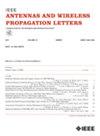圆波导中的电磁角动量分析
IF 4.8
2区 计算机科学
Q2 ENGINEERING, ELECTRICAL & ELECTRONIC
引用次数: 0
摘要
角动量(AM)在无线通信和检测中起着多种关键作用,而波导是关键的传播环境。在波导中传播的电磁波携带耦合的自旋角动量(SAM)和轨道角动量(OAM),但具体的OAM模式组成和SAM-OAM耦合关系尚未完全解决。虽然先前的研究已经导出了波导本征模携带的平均OAM值,但由于无限可能的OAM状态组合产生相同的平均值,因此模糊性仍然存在。这项工作解决了两个关键的空白:首先,它得到了OAM模式分量的确定性分解,其次,它显示了圆波导中电磁波的SAM-OAM耦合关系。通过将杂化本征模解析分解为左手和右手极化分量,本研究揭示了每个极化分量携带具有不同拓扑电荷的OAM。此外,本研究的理论、HFSS模拟与前人的研究结果一致。本研究为圆波导中角动量传输奠定了理论基础,使其在OAM复用和量子通信中的应用成为可能。本文章由计算机程序翻译,如有差异,请以英文原文为准。
Analysis of Electromagnetic Angular Momentum in Circular Waveguides
Angular momentum (AM) plays multiple critical roles in wireless communications and detection, whereas waveguides serve as a pivotal propagation environment. The electromagnetic (EM) waves propagating in waveguides carry coupled spin angular momentum (SAM) and orbital angular momentum (OAM), yet the specific OAM mode composition and SAM-OAM coupling relationship have not been fully resolved. Although prior studies have derived average OAM values carried by waveguide eigenmodes, the ambiguity persists due to infinite possible OAM state combinations that yield identical averages. This work addresses two critical gaps: first, it obtains the deterministic decomposition of OAM mode components, and second, it shows the explicit SAM-OAM coupling relationship of EM waves in circular waveguides. By analytically decomposing hybrid eigenmodes into left-handed and right-handed polarized components, this study reveals that each polarization component carries OAM with distinct topological charges. Moreover, consistency is demonstrated among the theory of this study, HFSS simulations, and prior research. As a result, this study establishes a theoretical foundation for angular momentum transmission in circular waveguides, which enables applications in OAM multiplexing and quantum communications.
求助全文
通过发布文献求助,成功后即可免费获取论文全文。
去求助
来源期刊
CiteScore
8.00
自引率
9.50%
发文量
529
审稿时长
1.0 months
期刊介绍:
IEEE Antennas and Wireless Propagation Letters (AWP Letters) is devoted to the rapid electronic publication of short manuscripts in the technical areas of Antennas and Wireless Propagation. These are areas of competence for the IEEE Antennas and Propagation Society (AP-S). AWPL aims to be one of the "fastest" journals among IEEE publications. This means that for papers that are eventually accepted, it is intended that an author may expect his or her paper to appear in IEEE Xplore, on average, around two months after submission.

 求助内容:
求助内容: 应助结果提醒方式:
应助结果提醒方式:


